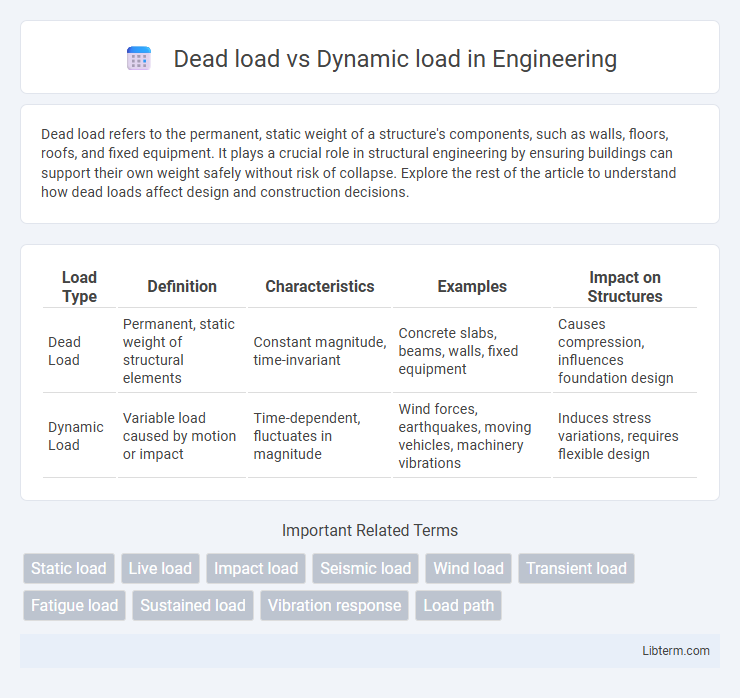Dead load refers to the permanent, static weight of a structure's components, such as walls, floors, roofs, and fixed equipment. It plays a crucial role in structural engineering by ensuring buildings can support their own weight safely without risk of collapse. Explore the rest of the article to understand how dead loads affect design and construction decisions.
Table of Comparison
| Load Type | Definition | Characteristics | Examples | Impact on Structures |
|---|---|---|---|---|
| Dead Load | Permanent, static weight of structural elements | Constant magnitude, time-invariant | Concrete slabs, beams, walls, fixed equipment | Causes compression, influences foundation design |
| Dynamic Load | Variable load caused by motion or impact | Time-dependent, fluctuates in magnitude | Wind forces, earthquakes, moving vehicles, machinery vibrations | Induces stress variations, requires flexible design |
Introduction to Dead Load and Dynamic Load
Dead load refers to the permanent, static weight of a structure, including components such as beams, walls, floors, and fixed equipment. Dynamic load involves forces that vary over time, such as wind, earthquakes, traffic, and machinery vibrations, which impose fluctuating stress on structural elements. Understanding the difference between dead load and dynamic load is essential for accurate structural design and safety assessments.
Definitions: Dead Load Explained
Dead load refers to the permanent, static weight of a structure's components, including walls, floors, roofs, and fixed equipment. It remains constant over time and does not vary with occupancy or environmental conditions. Understanding dead load is crucial for designing structural elements to ensure stability and safety under sustained weight.
Understanding Dynamic Load
Dynamic load refers to forces that are variable and change over time, including impacts, vibrations, and moving loads such as vehicles or machinery. Unlike dead loads, which consist of static, permanent weights like structural components, dynamic loads require engineers to analyze inertia, acceleration, and oscillation effects to ensure stability and safety. Accurate assessment of dynamic loads is critical in designing resilient structures capable of withstanding fluctuating stresses during their service life.
Key Differences Between Dead Load and Dynamic Load
Dead load refers to the constant, static weight of a structure and its permanently attached components, including walls, floors, and fixed equipment. Dynamic load involves variable forces that change over time, such as wind, traffic, earthquakes, and machinery vibrations, exerting fluctuating stresses on the structure. Key differences include the time variability, magnitude predictability, and the impact on structural design, where dead loads are typically steady and easier to calculate, while dynamic loads require complex analysis for safety and durability.
Importance of Load Analysis in Structural Engineering
Dead load refers to the constant, permanent weight of structural elements such as beams, walls, and floors, while dynamic load involves transient forces caused by moving objects, wind, or seismic activity. Accurate load analysis in structural engineering ensures safety, durability, and compliance with design codes by accounting for both types of loads. Evaluating dead and dynamic loads enables engineers to optimize material usage and prevent structural failure under varied conditions.
Examples of Dead Loads in Construction
Dead loads in construction include permanent structural components such as beams, columns, walls, and floors that consistently exert weight on a building. Other examples are fixed installations like roofing materials, concrete slabs, and built-in cabinetry, which contribute to the static load the structure must support. Understanding these loads is crucial for designing foundations and ensuring overall structural integrity.
Common Sources of Dynamic Loads
Dynamic loads arise from forces that vary with time, such as wind pressure, seismic activity, moving vehicles, and machinery vibrations, in contrast to dead loads which are static and constant like the weight of the structure itself. Common sources of dynamic loads include wind gusts impacting tall buildings, earthquakes generating ground motion, vehicle traffic on bridges, and operational equipment producing oscillations. Understanding these variable forces is crucial for structural design to ensure safety and resilience under fluctuating stress conditions.
Effects of Dead and Dynamic Loads on Structures
Dead loads cause constant, predictable stress on structures, contributing to permanent deformations and influencing the design for stability and strength. Dynamic loads introduce variable forces such as wind, earthquakes, and traffic, leading to vibrations, fatigue, and potential resonance that can compromise structural integrity. Understanding the combined effects of dead and dynamic loads is essential for ensuring safety, durability, and performance in structural engineering.
Methods for Calculating Dead and Dynamic Loads
Methods for calculating dead loads involve quantifying permanent, static weights such as structural components, fixtures, and immovable elements using material densities and standard dimensions. Dynamic load calculations require analyzing transient forces caused by movement, impact, or environmental effects through time-dependent models, impact factors, and vibrations using computational tools like finite element analysis (FEA). Structural engineers employ load combination protocols from standards such as ASCE 7 or Eurocode to integrate dead and dynamic loads accurately for safe design.
Best Practices for Managing Structural Loads
Dead loads consist of permanent, static forces such as the weight of structural components and fixed equipment, while dynamic loads involve variable forces like wind, traffic, and seismic activity. Best practices for managing these structural loads include precise load calculations, use of high-strength materials, and incorporation of load distribution systems to enhance stability. Employing real-time monitoring systems and performing regular structural assessments ensure timely detection and mitigation of stress-induced damage.
Dead load Infographic

 libterm.com
libterm.com